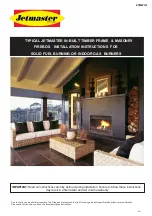
5
C.
C.
B.
A.
ficient. In unfavorable conditions, you can prime the chimney by
using a hair dryer or blowlamp, or by burning a small quantity of
paper in the clean outs at the base of your fireplace.
The maximum amount of wood that can be burnt in your fire-
place during each firing is about 0.8 lbs per 100 lbs of the mass
of the fireplace. For example, you can burn 16 lbs of wood per
firing in a fireplace weighing 2000 lbs. Wood can be burned in
2–3 loads, depending on the model. Load sizes and the recom-
mended maximum amount of wood for each model can be found
in a table on the back page of the operating manual. Use the
above-mentioned guidelines if you have a special model.
To light the fire, take about one fifth of the wood from the first
load and chop it into thin pieces of about 0,5”–1” in diameter.
First, place the rest of the larger pieces of wood crosswise on
the firebox grate. Lay kindling (a couple of firestarter blocks, a
piece of birch bark or paper) on top of the wood and light the
kindling. Finally, place the thin wood that you chopped on top of
the burning kindling (figure 6) and close the door.
If your fireplace is equipped with a by-pass damper, keep it open
for about 5–10 minutes during ignition. You can also open the
damper when you add more wood, but you should then close it im-
mediately once all the wood has been added. Keeping the damper
open for longer can raise the temperature in the flue extremely
high. Overheating can damage the flue or may even cause a fire.
Only add more wood once the previous load has burnt down al-
most to the coals and only small, but distinct, flames are visible.
Avoid filling the firebox above the height marked by the air gaps
in the firebox panels (figure 7). The recommended number of
extra loads for normal firing is 1–2.
Both the firebox and maintenance doors should be kept closed
during use. The only exceptions to this are those detailed in this
manual: during ignition, or when adding wood. Maintain all seals
in good condition.
ENDING FIRING
When the last load has burnt down to the coals, set the grate
damper to the ‘maintenance’ position and move the air control
lever on the firebox door to the ‘closed’ position. Use a suitable
tool to scrape the coals at the edges of the firebox into a layer
over the grate so that they will burn efficiently (figure 8). Stoke
the coals a couple of times until they are completely burnt. Then
set the air control lever on the maintenance door to the ‘closed’
position. You may also move the grate damper back to the ‘com-
bustion’ position. Finally, close the flue damper.
Remember! Carbon monoxide is an odorless, tasteless and col-
orless gas, so be careful.
During firing, and for a long period afterwards, the surfaces and
interior sections of your fireplace may be extremely hot. Your
fireplace’s surfaces are at their hottest about two to three hours
after firing has ended. Follow the instructions in this manual for
your safety and to prevent overheating.
Never store anything made from combustible materials on top of
or close to your fireplace, or on its mantles and shelves.
FIRING A COMBINED FIREPLACE/BAKE OVEN
A combined fireplace/bakeoven is fired in the same way as a
standard fireplace. Fire your bakeoven on the day prior to baking
so that it is still slightly warm when you fire it on the baking day.
Your bakeoven will then warm more evenly, giving you better
baking results. Please note that the bakeoven air control must
be completely closed when firing the firebox below.
Fireplace and bakeoven combinations delivered in the Unit-
ed States, Canada and Germany are equipped with a flip-flap
damper in the bakeoven. Flip-flap damper prevents the simul-
taneous use of firebox and bakeoven. During operation of the
fireplace, pull the damper to position I. While heating up the
bakeoven push it to position II. See drawing.
Before firing, open the flue damper and set the air control le-
ver on the bakeoven door to the ‘open’ position. Place firewood
lengthwise in the firebox and use kindling to help light the fire.
Pieces of firewood can be as long as will fit into the firebox. Max-
imum amounts are the same as for a standard fireplace.
Combustion air control settings, Tulikivi whirl chamber
Combustion phase
A
,
Air control lever setting
B
,
Grate damper
C
,
Air control lever setting
(on the maintenance door).
(on the firebox door).
Ignition
Open
Combustion
Open
Burning
Open
Combustion
Open
Coals
Open
Maintenance
Closed
Dark coals
Closed
Combustion
Closed


























